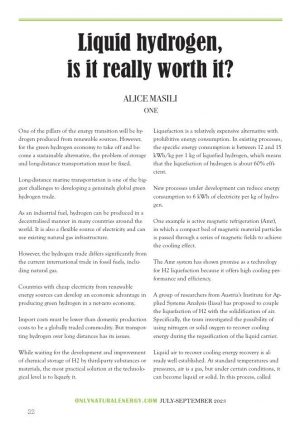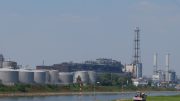 One of the pillars of the energy transition will be hydrogen produced from renewable sources. However, for the green hydrogen economy to take off and become a sustainable alternative, the problem of storage and long-distance transportation must be fixed.
One of the pillars of the energy transition will be hydrogen produced from renewable sources. However, for the green hydrogen economy to take off and become a sustainable alternative, the problem of storage and long-distance transportation must be fixed.
Long-distance marine transportation is one of the biggest challenges to developing a genuinely global green hydrogen trade.
As an industrial fuel, hydrogen can be produced in a decentralised manner in many countries around the world. It is also a flexible source of electricity and can use existing natural gas infrastructure.
However, the hydrogen trade differs significantly from the current international trade in fossil fuels, including natural gas.
Countries with cheap electricity from renewable energy sources can develop an economic advantage in producing green hydrogen in a net-zero economy.
Import costs must be lower than domestic production costs to be a globally traded commodity. But transporting hydrogen over long distances has its issues.
While waiting for the development and improvement of chemical storage of H2 by third-party substances or materials, the most practical solution at the technological level is to liquefy it.
Liquefaction is a relatively expensive alternative with prohibitive energy consumption. In existing processes, the specific energy consumption is between 12 and 15 kWh/kg per 1 kg of liquefied hydrogen, which means that the liquefaction of hydrogen is about 60% efficient.
New processes under development can reduce energy consumption to 6 kWh of electricity per kg of hydrogen.
One example is active magnetic refrigeration (Amr), in which a compact bed of magnetic material particles is passed through a series of magnetic fields to achieve the cooling effect.
The Amr system has shown promise as a technology for H2 liquefaction because it offers high cooling performance and efficiency.
A group of researchers from Austria’s Institute for Applied Systems Analysis (Iiasa) has proposed to couple the liquefaction of H2 with the solidification of air. Specifically, the team investigated the possibility of using nitrogen or solid oxygen to recover cooling energy during the regasification of the liquid carrier.
Liquid air to recover cooling energy recovery is already well established. At standard temperatures and pressures, air is a gas, but under certain conditions, it can become liquid or solid. In this process, called Solid Air Hydrogen Liquefaction, the cooling energy from the regasification of hydrogen is stored, and the air is solidified to transport it to the location where the hydrogen was liquefied.
The solidified air is then used to reduce the energy consumed to liquefy the hydrogen. The process includes 4 phases: hydrogen regasification, transport of solid nitrogen or hydrogen, liquefaction of hydrogen, and transport of liquid hydrogen.
The first step removes the cooling potential from liquid H2 to solidify nitrogen and oxygen.
Liquid nitrogen or oxygen is sprayed into a cryogenic tank.
Upon contact with liquid hydrogen, N2 or O2 solidifies and collects at the bottom of the tank, causing the temperature to drop to 20 Kelvin. As a result, H2 goes into the gaseous state.
At this point, the solid nitrogen or oxygen is returned to the original location where the liquid H2 was generated to utilise the cooling capacity of the solid N2 or O2 and cool the hydrogen gas as much as possible. The hydrogen gas enters the tank as it cools, while the N2 or O2 returns to the liquid state and is gradually removed to cool the H2 outside the tank through heat exchangers.
The H2 is cooled down to about 30 Kelvin. An additional refrigeration system provides the further cooling required to liquefy the H2.
After liquefaction, the hydrogen is loaded into an empty tank and transported to the regasification plant, where the cycle begins again.
According to this study, this process can reduce the energy required to liquefy hydrogen by 25,4% when using N2 and 27,3% when using O2. Lower energy consumption and lower costs for transporting hydrogen between continents would increase the viability of a global hydrogen market and hydrogen suppliers for countries with high energy demand.
Alice Masili


